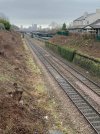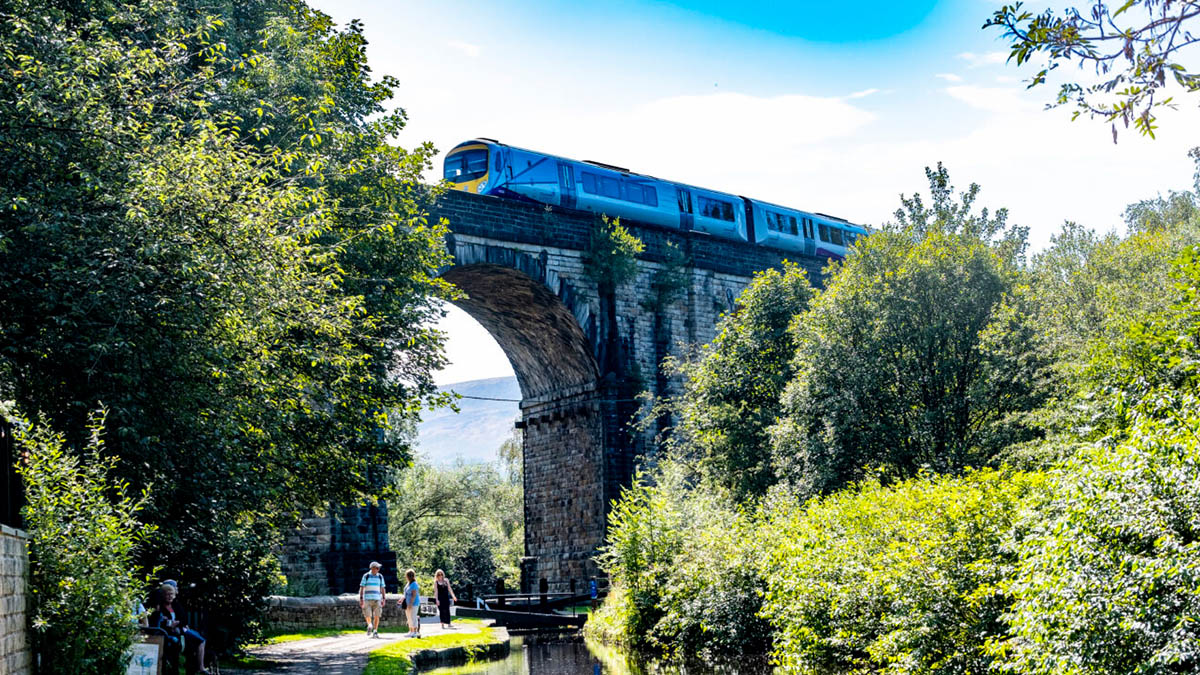GRALISTAIR
Established Member
Thanks for these. Most of the photos I have seen are from inside the station or lineside, so showing this aspect is good. Thanks again.
Can we say yet when will TRU electrification east of the Pennines will be complete enough for diesel or bimode services to converted to EMU?Absolutely rapid progress being made.
If you read posts 8776 and 8789 you will learn of eye-witness progress not PR statements. There will be more piles in than masts erected and there will be about 20 masts per km. That means that mast erection could be complete this year, East of Leeds. Bridge work may (or not) take longer as it has to be planned ahead more. SPS and wiring can be quite speedy so it is not impossible to have East of Leeds wiring live in 2026. There is always ORR sign-off (can be quick) and staff training and stock testing to add to the timescale before a full new timetable can start. We might just be pleasantly surprised. There is however a lot to do West of Leeds before we're all-electric.Can we say yet when will TRU electrification east of the Pennines will be complete enough for diesel or bimode services to converted to EMU?
Now that Stalybridge is done, I guess that means when will Neville Hill to Colton Junction be completely wired, so that local services can switch to fully electric.
Indeed. W2B, W2C, design stage only iircThere is however a lot to do West of Leeds before we're all-electric.
WAO
Not to mention there are still quite a few blockades in the forthcoming months where progress can really ramp up.If you read posts 8776 and 8789 you will learn of eye-witness progress not PR statements. There will be more piles in than masts erected and there will be about 20 masts per km. That means that mast erection could be complete this year, East of Leeds. Bridge work may (or not) take longer as it has to be planned ahead more. SPS and wiring can be quite speedy so it is not impossible to have East of Leeds wiring live in 2026. There is always ORR sign-off (can be quick) and staff training and stock testing to add to the timescale before a full new timetable can start. We might just be pleasantly surprised. There is however a lot to do West of Leeds before we're all-electric.
WAO
That's what I thought. Thank you.Of course thanks to the Neville Hill and Leeds East viaduct works we’re still a few years off seeing EMUs deployed on the local stopping services which is when we’ll really see the greatest benefits of electrification. Until then there’s not going to be a noticeable change for the passenger experience if it’s just 802s using the wires and if the linespeed remains at 90mph for the most part.
https://thetrupgrade.co.uk/benefits/ saysDo we know what the Manchester-Leeds journey time is expected to be when the Transpennine Route Upgrade is complete?
Faster journeys
We’re speeding up journeys so you can travel to your favourite towns and cities more quickly. Our fastest journey times are forecast to be 63-66 minutes between Manchester and York and 41-42 minutes between Manchester and Leeds.
About 10-12 miniutes faster than Northern Powerhouse Rail!Do we know what the Manchester-Leeds journey time is expected to be when the Transpennine Route Upgrade is complete?


I understood the viaduct line was taken out of use as it had a very severe speed restriction due to curvature which would also prevent use of modern stock unless the line were singled.A couple of photos taken today from the Dragon bridge in Leeds. The electrification works towards Morley can be seen on the westbound shot, and the lack of same on the eastbound shot looking towards Leeds. The gap between the new works and the existing OHLE at Leeds is approx 1000 yards.
View attachment 173489
View attachment 173490
The grey industrial unit in the westbound shot lies approximately on the site of the former Farnley and Wortley station. This would have to be demolished if "they" ever saw sense and brought the former viaduct line back into use (together with another bridge over the canal in Leeds) giving unconflicted access into the southern platforms. Something that would probably have given more benefits at a fraction of the cost of the Ravensthorpe works
Agreed- the curvature of that viaduct was such to render it utterly unsuitable for modern stock. The only way it could be of practical use for transit would be as part of a tram system. Maybe if it had been demolished once the track was lifted, it wouldn't get brought up so often. The idea that it would offer the same sort of benefits as the grade separation at Thornhill LNW Junction is frankly laughable.I understood the viaduct line was taken out of use as it had a very severe speed restriction due to curvature which would also prevent use of modern stock unless the line were singled.
I think the Mods will get upset if we discuss this here. I have made a posting on the Speculative Discussions "Suggestions for new shortish lines" thread to amplify this.Agreed- the curvature of that viaduct was such to render it utterly unsuitable for modern stock. The only way it could be of practical use for transit would be as part of a tram system. Maybe if it had been demolished once the track was lifted, it wouldn't get brought up so often. The idea that it would offer the same sort of benefits as the grade separation at Thornhill LNW Junction is frankly laughable.
I wonder if the replacement bridge adjacent to Neville hill depot has the same headroom as the previous.
Was passing today, so thought I'd have a look.
The headroom appears to have been reduced, at least according to the signage.
Height restriction is now showing as 13'3" (4.0m)
Before the works it as 14'3" (4.3m)
As a local down and around the works everyday, depending on weather. The progress seen is always at snailspace to me. on one section they started and sort of 1/2 done if that, Nothing has changed since April 2023, machines all went off hire, still the same today. but elsewhere slow progess, afterall no rush it's taxpayers money. Like any big government funded project, it will run late and over budget IMOI’ve been following the progress of the TRU on the forum.
I recently travelled between Huddersfield and York. The first time for a while. I was surprised at the general level of engineering activity all along this stretch of the line.
Nothing prepares you though for the work between Huddersfield and Ravensthorpe. The scale of the civil engineering works is immense and very impressive. Well worth the trip!
Must be the same idea as the crossover to the north east of Batley, allowing trains to terminate and turnaround at Greenfield whilst works take place on Marsden tunnel.It's posted on RMWeb that a signal with a junction indicator has appeared, along with markings on the rails giving the positions of two crossovers to be added between Greenfield and Saddleworth Viaduct.
I thought trains could already turn back at Diggle loop, can they not? They can turn back at Marsden station (the other end of Standedge tunnel) but this does mean using platform 3 which is awkward due to the positioning of the starting signal*.Must be the same idea as the crossover to the north east of Batley, allowing trains to terminate and turnaround at Greenfield whilst works take place on Marsden tunnel.
Marsden P2 can also be used for turnbacks. P3 is still awkwardI thought trains could already turn back at Diggle loop, can they not? They can turn back at Marsden station (the other end of Standedge tunnel) but this does mean using platform 3 which is awkward due to the positioning of the starting signal*.
The Batley turnback crossover is for the longer blockades when the new junction at Ravensthorpe is plugged in, though it may also come in useful in the other direction when Morley Tunnel is being worked on.
*= That particular issue may have been fixed now, it was certainly a problem in the past as 185s had to be local door only.
I was at Diggle last week, the loop line looked rather derelict , the sleeper ends near the canal tunnel mouth are undermined and to my eye , unsafe. Is the loop to be dispensed with in the near future? There was a lot of new cable ducting being installed on the other side, also east of Greenfield Station.I thought trains could already turn back at Diggle loop, can they not?
Thanks. Though P2 isn't accessible, so turning back there is presumably a no-no? Is taxiing people who can't use the steps from Slaithwaite or Huddersfield acceptable from that perspective?Marsden P2 can also be used for turnbacks. P3 is still awkward
IIRC the Diggle loop is being decommissioned as part of the upgrade, don't know if it's already beyond use but your description suggests it might be. In which case, an alternative facility will be needed while Standedge is blocked.I was at Diggle last week, the loop line looked rather derelict , the sleeper ends near the canal tunnel mouth are undermined and to my eye , unsafe. Is the loop to be dispensed with in the near future? There was a lot of new cable ducting being installed on the other side, also east of Greenfield Station.

AtkinsRéalis has been selected by Network Rail to oversee design integration for the 29km middle section of the Transpennine Route Upgrade (TRU) between Stalybridge and Huddersfield.
The appointment falls under an eight-year Lead Design Organisation (LDO) framework, where AtkinsRéalis will be responsible for a variety of services crucial to the project’s success. These include engineering management, design integration, schedule coordination, Building Information Modelling (BIM) and survey management.
The scope of work will involve the strengthening of up to 40 bridges, renewing 62km of track and remodelling four stations, among other infrastructural improvements.
The TRU is a multi-billion-pound initiative aimed at enhancing passenger connections and promoting sustainable travel within the North of England, linking key cities such as Manchester, Huddersfield, Leeds and York. The programme is part of broader ambitions to reduce journey times and facilitate greener travel options through the electrification of the railway.
Currently, the Stalybridge to Huddersfield route section, known as W2BC, is under survey by specialist teams. This preparatory work aims to gather in-depth information about terrain and potential obstacles before construction begins, ensuring that planning is informed by an accurate understanding of the route’s characteristics.

 railuk.com
railuk.com
RailUK said:AtkinsRéalis, a world-class engineering services and nuclear company with offices around the world, has been appointed by Network Rail to lead design integration for a central section of the Transpennine Route Upgrade (TRU), the 18-mile leg from Stalybridge to Huddersfield.
Under an eight-year Lead Design Organisation (LDO) framework, AtkinsRéalis will provide critical integration and design services to Network Rail including engineering management, design integration, schedule integration, BIM and survey management – spanning from design through to construction. This will involve strengthening up to 40 bridges, 62km of track renewals, and remodelling four stations, among other work.
